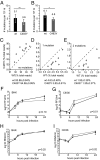Arbovirus high fidelity variant loses fitness in mosquitoes and mice
- PMID: 21896755
- PMCID: PMC3179076
- DOI: 10.1073/pnas.1111650108
Arbovirus high fidelity variant loses fitness in mosquitoes and mice
Abstract
The error rate of RNA-dependent RNA polymerases (RdRp) affects the mutation frequency in a population of viral RNAs. Using chikungunya virus (CHIKV), we describe a unique arbovirus fidelity variant with a single C483Y amino acid change in the nsP4 RdRp that increases replication fidelity and generates populations with reduced genetic diversity. In mosquitoes, high fidelity CHIKV presents lower infection and dissemination titers than wild type. In newborn mice, high fidelity CHIKV produces truncated viremias and lower organ titers. These results indicate that increased replication fidelity and reduced genetic diversity negatively impact arbovirus fitness in invertebrate and vertebrate hosts.
Conflict of interest statement
The authors declare no conflict of interest.
Figures




References
-
- Vignuzzi M, Wendt E, Andino R. Engineering attenuated virus vaccines by controlling replication fidelity. Nat Med. 2008;14:154–161. - PubMed
Publication types
MeSH terms
Substances
LinkOut - more resources
Full Text Sources
Medical
Research Materials

